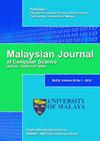朝圣航班优化问题的一种新调度方法
IF 1.2
4区 计算机科学
Q4 COMPUTER SCIENCE, ARTIFICIAL INTELLIGENCE
引用次数: 2
摘要
世界各地机场管理部门的主要目标是为乘客服务提供便利,并尽可能减少等待时间。这可以通过调节机场各个阶段的乘客流量来实现,包括到达和离开大厅、护照检查站、行李处理和海关。这项研究的重点是改善沙特阿拉伯王国阿卜杜勒阿齐兹国王国际机场(KAIA)朝觐航站楼的乘客流量,因为它是朝觐季节最受游客欢迎的车站之一,也是世界第四大客运航站楼。应用三种不同的优化算法来改进将到达航班分配到可用机场登机口以及各个机场休息室和区域内的阶段的调度过程。这些算法分别是遗传算法(GA)、和谐搜索算法(HSA)和差分进化算法(DEA)。结果提供了整个乘客到达过程的先验知识,并显示了容易出现拥堵和导致过程延迟的阶段。在适应度值和收敛速度方面的实验性能结果表明,当种群大小等于5时,GA优于HSA和DEA,而当种群大小分别等于20和50时,DEA与其他算法相比具有更好的性能。此外,结果显示,由于护照区缺乏分配的空间,乘客等待时间最长的是登机口休息室,其次是行李区,然后是护照检查区和海关区。本文章由计算机程序翻译,如有差异,请以英文原文为准。
A NOVEL SCHEDULING APPROACH FOR PILGRIM FLIGHTS OPTIMIZATION PROBLEM
The main goal of airport administrations around the world is to facilitate the conduct of passenger services and reduce waiting time as much as possible. This can be achieved by regulating the flow of passengers at the various stages of the airport, including arrival and departure halls, passport checkpoints, luggage handling, and customs. This study focuses on improving the flow of passengers in the Hajj terminal at King Abdulaziz International Airport (KAIA) in the Kingdom of Saudi Arabia, as it is one of the most welcoming stations for travelers during the Hajj season and is the fourth largest passenger terminal in the world. Three different optimization algorithms are applied to improve the scheduling process of assigning the arrival flights to available airport gates, as well as the stages inside the various airport lounges and areas. These algorithms are genetic algorithm (GA), harmony search algorithm (HSA), and differential evolution algorithm (DEA). The results give a prior knowledge of how the whole passengers’ arrival process and show the stages that are prone to congestion and cause process delay. Experimental performance results in terms of fitness value and convergence rate show that GA outperforms HSA and DEA when the population size is equal to 5, whereas DEA provides better performance compared to other algorithms when the population size is equal to 20 and 50. Moreover, the results show that the largest waiting time for passengers was in the arrival gate lounges due to the lack of allocated spaces in the passport areas, followed by the luggage area, then the passport control and customs areas, respectively.
求助全文
通过发布文献求助,成功后即可免费获取论文全文。
去求助
来源期刊

Malaysian Journal of Computer Science
COMPUTER SCIENCE, ARTIFICIAL INTELLIGENCE-COMPUTER SCIENCE, THEORY & METHODS
CiteScore
2.20
自引率
33.30%
发文量
35
审稿时长
7.5 months
期刊介绍:
The Malaysian Journal of Computer Science (ISSN 0127-9084) is published four times a year in January, April, July and October by the Faculty of Computer Science and Information Technology, University of Malaya, since 1985. Over the years, the journal has gained popularity and the number of paper submissions has increased steadily. The rigorous reviews from the referees have helped in ensuring that the high standard of the journal is maintained. The objectives are to promote exchange of information and knowledge in research work, new inventions/developments of Computer Science and on the use of Information Technology towards the structuring of an information-rich society and to assist the academic staff from local and foreign universities, business and industrial sectors, government departments and academic institutions on publishing research results and studies in Computer Science and Information Technology through a scholarly publication. The journal is being indexed and abstracted by Clarivate Analytics'' Web of Science and Elsevier''s Scopus
 求助内容:
求助内容: 应助结果提醒方式:
应助结果提醒方式:


